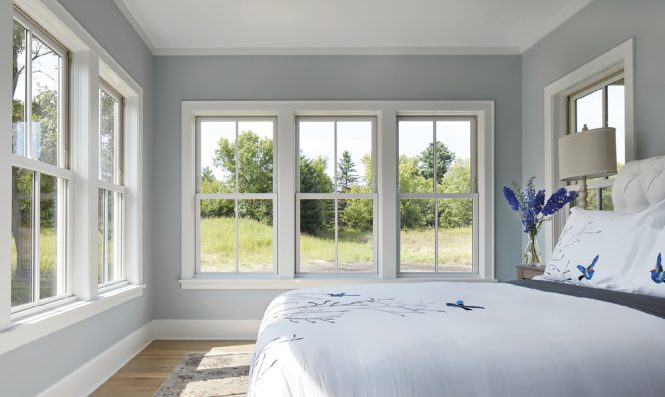4 Questions to Ask Before Replacing Your Windows
Presented by Williams Lumber & Home Centers | Fall 2021 | SPONSORED
If you’ve been dreaming of replacing your windows, you may already know that it can be quite an undertaking. Whether you’re looking to start a major renovation or want to upgrade your windows for increased comfort and a more modern look, there’s an array of choices that go into any replacement project.
To learn more about the process, we turned to the pros at Williams Lumber and Home Centers, the Hudson Valley’s premier dealer of Marvin windows and doors. With seven locations, including two design centers in Pleasant Valley and Rhinebeck, Williams has been a go-to for home improvement in the Hudson Valley since 1946.
Here are four questions from the experts at Williams that will help you determine the scope and scale of your project, and ensure you get the maximum return on your investment.
Should I repair or replace my windows?
When it comes to window replacement, the first question you should ask is how extensive the job needs to be. Knowing what’s repairable and what needs replacement can be a tough call.
If your issues are limited to painted-shut upper sashes, a few broken panes, worn sash cords and weatherstripping, or outdated hardware, you can probably limit your project to repairs. Other issues, like persistent draftiness or damage to the frames and sashes may indicate a full replacement project is on the horizon.
Need help deciding what’s right for you? Consult with the experienced team at Williams, who can help you navigate the process and provide priorities based on your specific issues.
Should I choose insert or full-frame window replacement?
If your windows definitely need to be replaced, the next step is to choose between insert and full- frame replacement.
Insert replacement, also known as “frame-in-frame replacement” or a “pocket window,” is when new windows are installed within the existing frames. It’s a simpler project, but only an option if your existing window frames are structurally sound. To complete the replacement, the existing sash, hardware, and cover are removed and the new window unit is inserted right into the old frame, where it’s then anchored, insulated, and sealed.
An insert replacement is a great option when you’re happy with the size, shape, and operating style of your existing windows. It also generally has a lower cost, so if budget is a priority and your frames are in good condition, this might be the choice for you.
Your other option is a full-frame replacement. That’s when the existing window is completely removed down to the studs—including interior and exterior trim, and occasionally siding—and the new window is installed in the opening.
Full-frame replacement is often necessary if your frames have sustained damage over the years or you’re remodeling your home. It’s a more extensive project, but also offers you more flexibility to replace your old window with a new style or size. It’s the perfect opportunity to replace hard-to-reach double hung windows with easy-to- open awning or casement windows, or to opt for a style that extends your view of the outdoors and lets more light into a room.

An insert window replacement is a great option if you’re looking to preserve your home’s historic details and your existing window frames are still in good shape. You can find examples of Marvin’s three premium product collections and range of customization options on display at the Williams Design Centers in Rhinebeck and Pleasant Valley.
Are energy-efficient windows right for my home?
Energy efficiency is a hot topic when it comes to windows—and for good reason. Energy efficient windows can make your home more comfortable, help save money on your utilities, and better meet the needs of your particular climate.
While it might be tempting to opt for windows sporting the newest technology, it’s important to know that your home’s overall existing energy efficiency will affect how much your windows can contribute to the equation. If your walls aren’t well insulated, even premier energy-efficient windows with insulating gas or triple-pane glass might not make much of a difference, especially in colder climates like the Northeast.
As an industry leader in energy efficiency, Marvin’s wide variety of flexible and customizable window options can help balance your initial investment with long-term performance and energy cost savings. Conducting a home energy audit can also help you decide if an investment in energy-efficient windows will be worth it over time.
What materials should I use?
While the materials used in your replacement windows may seem like decisions linked to aesthetic or cost decisions alone, each material type comes with its own list of pros and cons.
A classic, all-wood window offers a warm look and customization and design versatility, but requires more maintenance to upkeep. If your home is rich with historic or rustic details, however, wood might be the best choice for you.
If you’re looking for a lower-maintenance alternative, Marvin’s extruded aluminum or fiberglass windows are known for their exceptional strength and durability. Extruded aluminum is lightweight yet strong, which allows for large panes and thin window frames that let in copious amounts of light. Fiberglass can easily echo the look of wood, while maintaining its shape and insulating performance even in the most demanding climates.
It’s easier than you think to get started on replacing your windows. The expert team at Williams can help you understand and weigh the benefits of various window replacement options and provide the perfect match for your individual budget, maintenance needs, and personal style.
